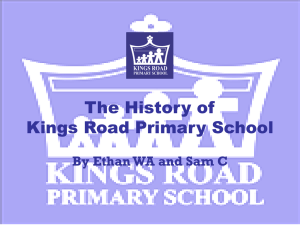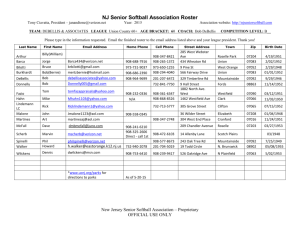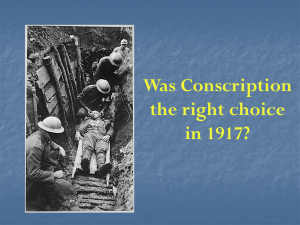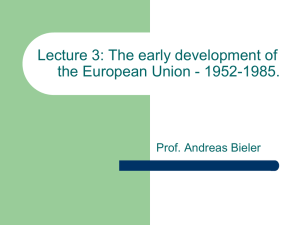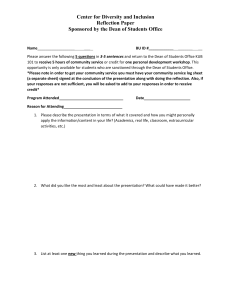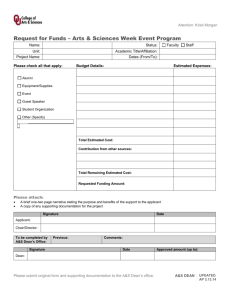Notes for Chapter Fifteen
advertisement
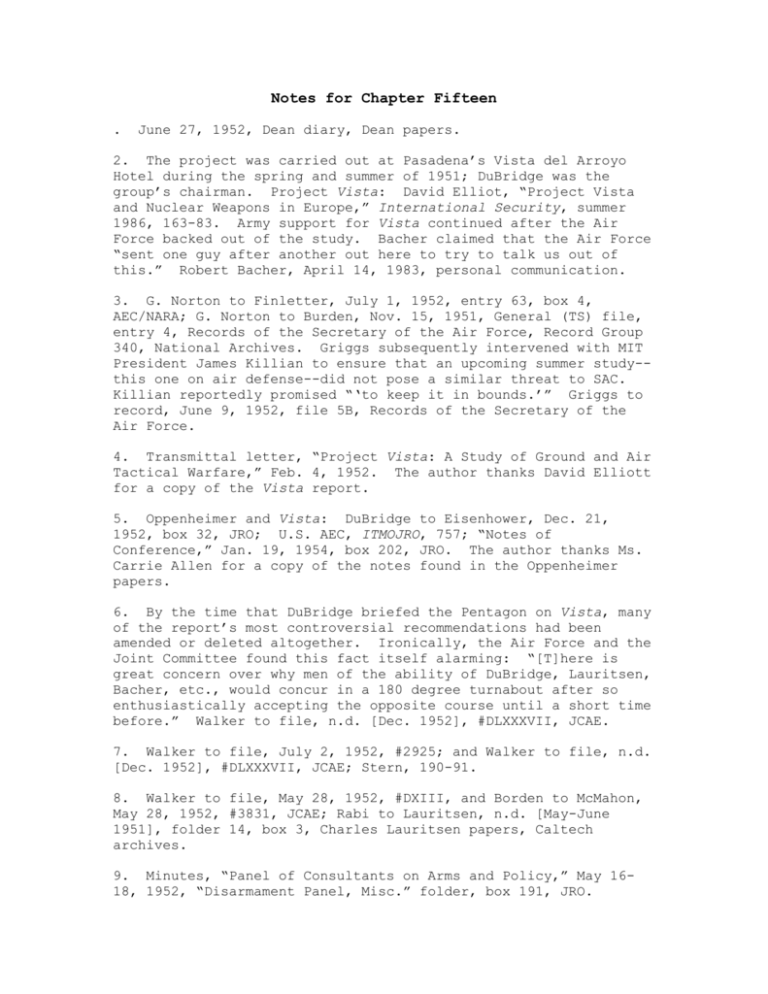
Notes for Chapter Fifteen . June 27, 1952, Dean diary, Dean papers. 2. The project was carried out at Pasadena’s Vista del Arroyo Hotel during the spring and summer of 1951; DuBridge was the group’s chairman. Project Vista: David Elliot, “Project Vista and Nuclear Weapons in Europe,” International Security, summer 1986, 163-83. Army support for Vista continued after the Air Force backed out of the study. Bacher claimed that the Air Force “sent one guy after another out here to try to talk us out of this.” Robert Bacher, April 14, 1983, personal communication. 3. G. Norton to Finletter, July 1, 1952, entry 63, box 4, AEC/NARA; G. Norton to Burden, Nov. 15, 1951, General (TS) file, entry 4, Records of the Secretary of the Air Force, Record Group 340, National Archives. Griggs subsequently intervened with MIT President James Killian to ensure that an upcoming summer study-this one on air defense--did not pose a similar threat to SAC. Killian reportedly promised “‘to keep it in bounds.’” Griggs to record, June 9, 1952, file 5B, Records of the Secretary of the Air Force. 4. Transmittal letter, “Project Vista: A Study of Ground and Air Tactical Warfare,” Feb. 4, 1952. The author thanks David Elliott for a copy of the Vista report. 5. Oppenheimer and Vista: DuBridge to Eisenhower, Dec. 21, 1952, box 32, JRO; U.S. AEC, ITMOJRO, 757; “Notes of Conference,” Jan. 19, 1954, box 202, JRO. The author thanks Ms. Carrie Allen for a copy of the notes found in the Oppenheimer papers. 6. By the time that DuBridge briefed the Pentagon on Vista, many of the report’s most controversial recommendations had been amended or deleted altogether. Ironically, the Air Force and the Joint Committee found this fact itself alarming: “[T]here is great concern over why men of the ability of DuBridge, Lauritsen, Bacher, etc., would concur in a 180 degree turnabout after so enthusiastically accepting the opposite course until a short time before.” Walker to file, n.d. [Dec. 1952], #DLXXXVII, JCAE. 7. Walker to file, July 2, 1952, #2925; and Walker to file, n.d. [Dec. 1952], #DLXXXVII, JCAE; Stern, 190-91. 8. Walker to file, May 28, 1952, #DXIII, and Borden to McMahon, May 28, 1952, #3831, JCAE; Rabi to Lauritsen, n.d. [May-June 1951], folder 14, box 3, Charles Lauritsen papers, Caltech archives. 9. Minutes, “Panel of Consultants on Arms and Policy,” May 1618, 1952, “Disarmament Panel, Misc.” folder, box 191, JRO. 0. Standstill: Minutes, “Disarmament Panel, Misc.” folder, box 191, JRO. Bush’s standstill idea also found support from the “Committee to Save the World,” the name that Rabi jokingly gave to the informal lobby that he, Oppenheimer, and Charlie Lauritsen had recently formed, to counter-act those who had suppressed the Vista report. However, Griggs, who had heard rumors of the group, and was also in possession of the classified minutes of the Disarmament Panel’s meetings, thought Rabi’s appellation more sinister than humorous. Walker to file, n.d. [Dec. 1951], #DLXXXVII, JCAE. 1. FRUS: 1952-54, II, Part 2, 1001; ITMOJRO, 248. 2. Arneson to Acheson, Sept. 29, 1952, FRUS: 1952-54, II, Part 2, 1017-1025. 3. The panel’s memo concluded: “Let us postpone the test if such a decision can be understood, explained, and properly supported.” Recognizing how controversial their proposal was likely to be, panel members decided against “presenting their views on this matter formally,” they informed Acheson. FRUS: 1952-54, II, Part 2, 994-1008; Bernstein, “Crossing the Rubicon: A Missed Opportunity to Stop the H-bomb?,” International Security, fall 1989, 143. 4. “I did nothing whatever about it,” Oppenheimer would later testify. ITMOJRO, 247. 5. Anders (ed.), 224. What Oppenheimer intended to say at his meeting with Truman occasioned anxiety among both the Joint Committee and Teller. However, no mention was made by Oppie of the standstill idea or postponing Mike. Walker and Hamilton to file, July 1, 1952, #2914, JCAE. GAC swan song: Oppenheimer to Truman, June 14, 1952, #74674, CIC/DOE. 6. Hershberg (1993), 603. 7. Aides reported to Finletter that the State Department was planning to recommend not only that Mike be postponed indefinitely, but that the U.S. and Russia jointly agree to regard any thermonuclear test as an act of war. LeBaron had heard that the panel would urge “that all U.S. thermonuclear efforts cease.” Walker to file, n.d. [Dec. 1952], #DLXXXVII, JCAE. 8. McMahon’s illness did not extinguish his hopes of becoming his party’s vice presidential nominee. On June 14, 1952, speaking by telephone from his hospital bed, McMahon addressed Connecticut’s Democratic delegation in Hartford, pledging, if elected, to build H-bombs “numbered in four figures” and to substitute “cheap atomic and hydrogen firepower for expensive conventional firepower.” McMahon died on July 28, 1952. 9. Cooksey to A. Loomis, May 6 and 10, 1952, folder 10, carton 46, EOL. 20. The AEC approved “[e]arly participation of [the Rad Lab] in the diagnostic measurements field, and later along such additional lines as may be determined by the Commission.” Dean to Regents, June 9, 1952, AEC/NARA. 2. Dean agreed to add a phrase to his letter to the Regents-“the Commission hopes that the group at UCRL will eventually suggest broader programs of thermonuclear research”–-but even this seeming concession had strings attached: the nature of the research was still unspecified, as was the question of whether the work would be done at Livermore “or elsewhere.” Murray complained that the AEC chairman’s letter made it “clear that at least in Dean’s mind this action with regard to Berkeley did not constitute the establishment of a second laboratory strictly speaking.” TEM diary, I, Part 1, 18; Jacobvitz to Brinck, April 29, 1954, #79166, CIC/DOE. 22. Bradbury knew better. “[A]n institution once founded never dies,” he wearily observed to the AEC. York to Bradbury, June 3, 1952, #125187, and Bradbury, “Observations on the Livermore Laboratory Proposal,” May 21, 1952, #125188, CIC/DOE. 23. Sybil Francis, “Warhead Politics: Livermore and the Competitive System of Nuclear Weapon Design” (University Microfilms, 1996), 58. 24. York interview (1997) 25. Walker to Borden, April 7, 1952, #2738, JCAE. 26. Hayward to “all concerned,” July 23, 1952, AEC/NARA. 27. LeBaron had evidently tried to reconcile the two warring parties at breakfast that morning, without success: “Gradually, as time passed, Teller, as he had with Bradbury, began to usurp Lawrence’s role. No one had ever challenged his authority before. It was not an experience he enjoyed. In his own way, he let Teller feel his displeasure.” Transcript of interview by Lin Root, n.d., folder 4, box 1, LeBaron papers. 28. Walker to file, Nov. 10, 1952, #DCVII, JCAE. The key paragraph of Dean’s letter read: “I think as a result of our conversation in Washington that you have complete understanding as to the type of effort that we both want to see go forward at the Radiation Laboratory...As we discussed, the Commission considers that the needs of this program are such that an additional and broad effort is indicated.” Dean to Lawrence, July 17, 1952, folder 18, carton 33, EOL. “Tell Teller he can blow up anything he wants,” Dean reportedly told Hayward. Hayward interview (1996). 29. As Underhill pointed out, there was still no charter for Livermore, nor any AEC-approved agreement on its final mission or scope. Underhill to Dean, July 1, 1952, AEC #425/21, AEC/NARA. 30. 3. TEM diary, II, Part 1, 19. Walker and Hamilton to file, July 1, 1952, #2914, JCAE. 32. Teller’s confidant was journalist Stephen White. Rabi interview (1983). Although Teller subsequently denied making the comment to White, he wrote of his decision to go to Livermore: “I turned away from my original choice–-to work on pure science–with my eyes open.” Teller (1987), 122. 33. AEC #295/60, Oct. 10, 1952, AEC/NARA. 34. Bevatron: 35. Alvarez (1987), 176-77. Childs, 446; Hewlett and Duncan, 500-501. 36. Dean to Lay, Oct. 30, 1952, AEC/NARA. Had the bomb been tested earlier, as Teller had urged, the AEC concluded that a failure was likely. Rhodes (1995), 487. 37. Bethe had written to Dean that fall, urging that the test be delayed until mid-November--”to give the smoke of battle time to dissipate.” Bethe to Dean, Sept. 9, 1952, #73974, CIC/DOE. Dean’s fear was that the public might think “the accomplishment of a thermonuclear reaction had made us invincible, that we could now take chances in foreign policy and perhaps even risk a major war.” June 20, 1952, Dean diary, Dean papers. 38. Nov. 21, 1952, Dean diary, Dean papers. 39. Anders (ed.), 226-27. 40. Dean to AEC directors, Oct. 30, 1952, #102137, CIC/DOE; Hewlett and Duncan, 592. 4. 42. Mike test: Rhodes (1995), 509; Hansen (1988), 56-57. Murray (1960), 20-21. 43. Teller and Brown, 55-56; York interview (1997); transcript of Bradbury interview, Bancroft Library. 44. The resignation letter, drafted by DuBridge but never sent, concluded: “The Committee has had few occasions to render advice. Indeed the committee believes that its continued existence, as presently conceived and constituted, is no longer needed for the national interest.” SAC/ODM: Herken (1992), 54-58; draft letter, “Nov. 1952”, folder 9, box 186, DuBridge papers. 45. Princeton meeting: (1993), 569. 46. various letters, box 189, JRO; Hershberg Walker to file, July 2, 1952, #2925, JCAE. 47. That fall, Borden sent the Joint Committee chairman a 64page “working paper” that detailed the charges against Oppenheimer. Borden to Cole, Nov. 3, 1952, #DCXXXV, JCAE. 48. Although “tapped” by Yale secret society Skull and Bones, Walker declined to join. Walker: Ken Mansfield interview (1993); transcript of John Walker interview by Jack Holl June 18, 1976. The author thanks Ken Mansfield for a copy of the Walker interview. Cotter: Frank Cotter, Oct. 21, 1997, personal communication. 49. “The Scale and Scope of Atomic Production: A Chronology of Leading Events” [A-bomb Chronology], Jan. 30, 1952, “Atomic Program Chronology” folder, series 2, JCAE. 50. 5. McMahon to Dean, May 7, 1952, #DCCIX, JCAE. Anders (ed.), 211. 52. One of Finletter’s aides speculated that Bethe’s chronology had been “solicited by Dr. Oppenheimer et al as a white-wash of their activities.” Walker to files, Oct. 3, 1952, #3049, JCAE; Bethe, “Memorandum on the History of the Thermonuclear Program,” May 28, 1952, box 4930, AEC/NARA; Walker to file, June 25, 1952, #DXXXVI, JCAE. 53. In spring 1951, when the Joint Committee was preparing its own report on Soviet atomic espionage, Borden had to be coaxed into deleting allegations concerning possible spies and “‘unproven acts of espionage,’” lest they compromise on-going investigations. There “may yet be another Fuchs in the project,” the committee’s intelligence expert warned Borden. JCAE, “Soviet Atomic Espionage,” (G.P.O., April 1951); Sheehy to Borden, March 20, 1951, #2036, JCAE. 54. Mansfield to Borden, May 28, 1951, #CCCXXXI, JCAE. 55. Borden noted in executive session that “it occurred to us that at the time of Fuchs’ apprehension there were indications that there might be another Fuchs in the project, and the committee might wish to inquire into the present status of efforts to locate the second Fuchs, if he exists.” Minutes, April 14, 1953, #DCLXII, JCAE. Second Fuchs: Walker to Borden, April 3, 1952, #2742, and Fields to Borden, May 5, 1952, #2773, and Mansfield to file, May 28, 1952, #DLVI, JCAE. 56. The president was told about the document by the Joint Committee’s acting chairman, Congressman Carl Durham, the day following the Inauguration; Ike asked to see a copy a few days later. Wheeler interview by Holl; Richard Hewlett and Jack Holl, Atoms for War and Peace, 1953-1961: Eisenhower and the Atomic Energy Commission (Univ. of Calif. Press, 1989), 34. Eisenhower did not acknowledge receipt of the chronology until Feb. 14, 1953; by then it had been completely overshadowed by the Wheeler incident. 57. Borden and Walker contemptuously dismissed Bethe’s counterchronology as a “whitewash;” the Cornell physicist had not even been at the 1946 conference, they pointed out. Walker to files, Oct. 3, 1952, #3049, JCAE. 58. Walker to Borden, July 16, 1952, #3098, JCAE. 59. Pike to McMahon, June 12, 1950, AEC/NARA; 1950 Fuchs interview: Robert Lamphere to Hoover, June 6, 1950, serial 1412, Klaus Fuchs file, #65-58805, FBI. 60. “Committee Business,” Feb. 18, 1953, #3281, JCAE. 6. Cotter to Borden, Jan. 27, 1953, #3217, and Dean to Cole, April 9, 1953, #DCXV, JCAE; Hewlett and Holl, 38. A subsequent “damage assessment” done for the AEC by Bethe, Teller, and others--based on the documents that Walker sent Wheeler-concluded that it “clearly reveals the idea of the radiation implosion” as well as “construction elements” of Mike. The document likewise discussed the use of lithium in the place of liquid deuterium. In his memoirs, Wheeler misremembered what was in the lost document. Wheeler and Ford (1998), 285. 62. Wheeler incident: “Committee Business,” Feb. 18, 1953, #3281, and Cotter to file, March 25, 1953, #3389, JCAE. Wheeler returned to his Princeton office to find the envelope in which he thought he had put the papers, empty. Brobeck to files, Feb. 12, 1953, JCAE. Although the train was also reportedly carrying Rosenberg supporters to a rally protesting the couples’ pending execution, one of the agents who interviewed the passengers claimed he “couldn’t even find a [expletive] Democrat on that train.” Mansfield interview (1993). 63. “Meeting with President Eisenhower and NSC,” Feb. 16, 1953, Mansfield papers. The unknown author of these notes writes of Ike’s reaction: “I never saw anyone more excited and concerned. I remember [Eisenhower] saying that if this had happened in the Army the man would have been shot.” 64. Dean diary, Feb. 17, 1953, Dean papers. 65. Borden interview (1981). 66. Borden tried, unsuccessfully, to distract attention incident. That April, he blamed the AEC and the FBI for to warn the White House about two individuals he claimed real security threats--Hans Bethe and Phillip Morrison. to Cole, April 15, 1953, #DCXVII, JCAE. from the failing were Borden 67. Fidler interview. During an earlier meeting in Lawrence’s office, Norris Bradbury had been “insistent” that Teller not be put in charge of the new lab. Hayward interview (1993). 68. Livermore origins: “Resume of Meeting,” Aug. 19, 1952, LBL archives; Preparing for the 21st Century: 40 Years of Excellence, The Lawrence Livermore National Laboratory (1998, LLNL), 5-10 ; Phil Schiedermayer, “Recollections, Reminiscences, Reflections,” UCRL-AR-125101, July 1996, and various interviews, LLNL. 69. Even at this late date, Lawrence “said it was not intended that Livermore should become the second major weapons laboratory.” Minutes, AEC #744, Sept. 8, 1952, AEC/NARA. Ramrod: interviews. As its name implied, Ramrod was intended to ignite deuterium by compression. 70. Project Whitney, York’s name for the weapons program at Livermore, was evidently inspired by Wheeler’s Project Matterhorn at Princeton. The AEC had originally hoped to keep the weapons work at Livermore a secret. AEC to Cooksey, Feb. 25, 1953, LBL. 7. Responsibility for the new Alarm Clock was transferred from Los Alamos to Livermore that summer. AEC #425/24, Aug. 18, 1952, AEC/NARA. Before it arrived at the lab, Livermore’s Univac was used to successfully predict the outcome of 1952's presidential election. Walker to file, Nov. 10, 1952, #DCVII, JCAE. 72. Francis (1996), 67. 73. Daring and bold did not always mean practical. One early experiment--by an inventor whose boyhood was spent near southern California’s orange groves--looked into using smoke to protect cities from the heat of nuclear explosions. Black clouds billowing from an Army-supplied smoke generator mystified the lab’s neighbors, until Livermore scientists realized that smog was also an effective insulator. Transcript of Arthur Hudgins interview, LLNL. 74. Hydride bomb: “Procurement of Deuterated Polyethylene,” Oct. 17 and 24, 1952, LBL; interviews with Wallace Decker and Kenneth Street, LLNL. 75. Lawrence’s invention--a single-gun tube using a color dividing grid--offered greater simplicity and a brighter picture than RCA’s three-gun tube, which was the industry standard. Lawrence’s Chromatics tube was later perfected and marketed by Sony under the trade name Trinitron. Chromatics: various correspondence, folder 3, carton 4, EOL; Childs, 420-26; transcript of interviews with Alvarez and Gaither, box 1, Childs papers; Crawford Cooley, May 29, 1997, personal communication. 76. Neylan’s intervened with the Regents to ensure that Lawrence retained sole patent rights on the tube. 77. “If you guys are going to do this kind of business, you are going to have to learn to put out a better looking product,” a Los Alamos physicist scolded his Livermore counterpart. Ruth test: Hansen (1988), 39 fn.; transcript of Wallace Decker interview, LLNL; Francis (1996), 68. 78. Eisenhower briefing: Hewlett and Holl, 3-5; Anders (ed.), 286. 79. Murray to Truman, Jan. 6, 1953, Murray papers. 80. Disarmament Panel report: FRUS, 1952-1954, II, Part 2, 110614, 1169-74. 81. Hewlett and Holl, 51. 82. Hewlett and Holl, 45. 83. Eisenhower was also reportedly concerned that he might be criticized for having too few Jews in his administration. Pfau, 137. 84. For weeks, Borden had been trying to locate notes of the summer 1942 seminar at Berkeley that had first discussed the super-bomb. After his meeting with Borden, Strauss spoke by telephone with Lawrence, Alvarez, and Pitzer. All knew of the Berkeley meeting and had been outspoken in their criticism of Oppie. Telegram, Borden to Lawrence, Dec. 23, 1952 and reply; Borden to Lawrence, Jan. 19, 1953, folder 25, carton 32, EOL. 85. Murphy’s principal source for the article had been Teddy Walkowicz, head of the Air Force’s Special Study Group, but Strauss reviewed the draft and evidently suggested changes. Like Strauss, Walkowicz was also an adviser to the Rockefeller brothers. Hewlett and Holl, 57; interview with Charles Murphy, June 12, 1954, section 42, JRO/FBI. Walkowicz was also the source of an erroneous claim that the Russians were first to test an H-bomb. The error, repeated in Edward Teller’s authorized biography, was caused by Walkowicz’s misinterpretation of an intelligence report concerning Russian fusion research. Blumberg and Owens, 266-73; Arnold Kramish, “The Thermonuclear Paradigm: Remaining Puzzles,” Sept. 1999; Mansfield to files, Oct. 30, 1953, #DCCCXVIII, JCAE. The author thanks Arnold Kramish for a copy of his unpublished paper. 86. Hewlett and Holl, 57. 87. Belmont to Ladd, May 23, 1952, section 12, JRO/FBI. Up until a week before the verdict, Oppenheimer had expected to be called to the witness stand. But his name came up only once in the trial, by accident, when the defense counsel referred to “Dr. Oppenheimer, I mean Dr. Weinberg.” Oppenheimer to Ruth Tolman, Feb. 27, 1953, box 72, JRO; Feb. 25, 1953, Dean diary, Dean papers. 88. “Weinberg Freed,” Kansas City Star, March 5, 1953. The head of Justice’s Criminal Division under Eisenhower, Warren Olney, told Hoover that he considered Weinberg’s delivery of secrets to Nelson in 1943 “a far more serious offense than the one committed by the Rosenbergs...” Olney had wanted to try Weinberg for treason--a crime which has no statue of limitations--using the FBI wiretap as the primary evidence, “notwithstanding the way in which it was gathered.” So protective of the Bureau’s wiretaps was the FBI director, however, that Hoover put Olney off by claiming, falsely, that the Navy had installed the bug and that both the notes and the original recording were missing. Transcript of interview with Warren Olney III, 351-54, Bancroft Library. Taking no chances, Weinberg’s defense attorney had filed a motion to suppress any evidence gathered by electronic means. Criminal docket, United States vs. Joseph W. Weinberg, May-June, 1953, U.S. District Court records, Washington, D.C. My thanks to Jim David for the records of the Weinberg trial. 89. Borden and McMahon had been Rickover’s ally in his protracted battles with the Navy’s “battleship admirals.” Polmar and Thomas Allen, Rickover: Controversy and Genius (Touchstone, 1982), 198; Pfau, 150. Norman 90. Allardice had been recommended to the Joint Committee by Strauss. Allardice: “Committee Business,” May 12, 1953, #3470, JCAE. 91. Previously, Borden had gone to the FBI for Oppenheimer’s security dossier. He was reluctant to go to the AEC for the file, Borden told the Bureau, “as this might stir up some speculation.” Tolson to Nichols, March 28, 1952, JRO/FBI. AEC records indicate that Borden returned the file on August 18, 1953; Strauss checked it out the next day. Waters to Strauss, May 12, 1954, Mansfield papers. 92. Borden to Allardice, May 29, 1953, 1953 Correspondence, JCAE. Hoover and CIA director Allen Dulles turned down the Joint Committee’s subsequent request to interview Fuchs. Cole to Hoover, July 14, 1953, #DCLXXI, and Hoover to Cole, July 16, 1953, #DCLXXXI, and Dulles to Cole, July 23, 1953, #DCLXXXIX, JCAE. Strauss opposed another Fuchs interview for the reason that it might inadvertently give U.S. secrets to the British. Strauss to Cole, July 24, 1953, #DCXC, JCAE. 93. “Questions raised in my mind by JRO file--WLB,” May 29, 1953, #DCXXXVIII, and Borden to Allardice, June 1, 1953, #DCXXXIX, JCAE. 94. Borden claimed in a 1981 interview that he had hoped someday to interrogate Oppenheimer personally, as the prosecutor in a trial for treason. Borden interview (1981).
